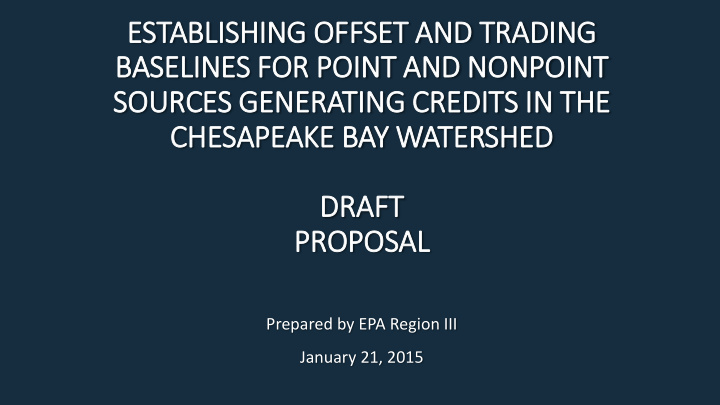



ESTABLISHING OFFSET AND TRADING BASELINES FOR POIN INT AND NONPOINT SOURCES GENERATING CREDITS IN IN THE CHESAPEAKE BAY WATERSHED DRAFT PROPOSAL Prepared by EPA Region III January 21, 2015
IN INTRODUCTION • Baselines used to generate credits for offsets and trades must be consistent with the Bay TMDL. The TMDL assumes specific baselines for point and nonpoint sources. 1. Point sources generating credits — the offsets baseline is the water quality-based effluent limit (WQBEL) included in that discharger’s permit consistent with the applicable WLA in the TMDL. For some point sources, the baseline will be a numeric limitation; for others, it will be a suite of BMPs determined to be protective of WQS. 2. Nonpoint sources generating credits — the baseline options should be consistent with the TMDL LA for the appropriate sector and may be further defined in terms of load, geographic scale, minimum practices, schedule of implementation and/or time needed to facilitate improved environmental compliance with WQS. • Baselines may be practice-based (using specified BMPs) or performance-based (using numeric limits). 1/21/2015 2
CONSISTENCY OF OFFSET AND TRADING BASELINES WIT ITH THE TMDL • A potential seller first must meet the baseline prior to being eligible to generate credits. • EPA expects the Bay Jurisdictions to: Use the same scale of source data used in developing the TMDL to determine baseline and credits generated. Report credit-generating projects and practices in their Annual Progress Review submission through the National Environmental Information Exchange Network (NEIEN). Report the load reductions used in trades and offsets by state-basin in each year for nitrogen, phosphorus and sediment. 1/21/2015 3
EVALUATING A PRACTICE-BASED BASELINE The comparison of the baseline as well as the pounds of credits generated by the specified practices implemented to the Bay TMDL allocation is expected to be made by: • Loading rate per acre • Land use • Major river basin . Assumption: x % of source sector * y BMPs = z pounds of nitrogen, phosphorus, or sediment where ‘y BMPs’ is shorthand for the total number of BMPs on the landscape, each with its own reduction value, across the total acres (% of source sector), which results in a total lbs reduction. 1/21/2015 4
EVALUATING A PRACTICE-BASED BASELINE, cont. • The loading rate per acre may be determined using a water quality model given the unrealistic costs of monitoring pollutant runoff at a farm scale. • The CBP Partnership has established a specified calculation methodology for determining the amount of reduction from any combination of approved practices. • Three steps for comparing a practice-based baseline with the Bay TMDL LA or WLA: 1. Specify the load for each land uses within each major basin that meets the TMDL, typically the WIP. The comparison is for the pounds of nitrogen, phosphorus, or sediment. 2. Determine the percent of acres, x , and set of BMPs, y , that achieves the TMDL allocation for sector (from step 1). 3. Compare the load with the TMDL per acre allocation for the sector (from step 1). 1/21/2015 5
EVALUATING A PRACTICE-BASED BASELINE, , cont. The determination should be repeated every two years. Comparison is noted with red arrows. The endpoint for determining if baseline is met is in green. The grey box is a comparison that need only be made once, not each time a credit is proposed for certification. Steps 1 and 2 may be conducted in parallel. 1/21/2015 6
EVALUATING A PERFORMANCE-BASED BASELINE • For credit calculations, there first must be a check to make sure that the credit generator is meeting baseline by comparing pre-Bay TMDL loads to current loads. • For a baseline assessment and credit calculation tool to produce loads comparable to those used to assess progress toward the Bay TMDL, the tool needs to be consistent with the Bay TMDL assumptions and the scale of the land uses and major-basin. The most robust approach is for a baseline assessment and credit calculation tool to use source parameters (e.g.: soils, hydrology, Bay delivery factors, etc…) that are at the same geographical scale and that use the same land uses as are used in assessing progress toward the Bay TMDL. EPA suggests that the soil data characteristics be averaged by county. EPA expects the Bay jurisdictions to be specific about the load that is designated to credit generators as “baseline load.” 7 1/21/2015
EVALUATING A PERFORMANCE-BASED BASELINE, cont. Two approaches for evaluating a performance-based baseline: 1. Consistent with modeled loads: Assess whether the nitrogen, phosphorus and sediment loads from a jurisdiction’s baseline assessment and credit calculation tool are consistent with the CBP Partnership Watershed Model loads. If NOT, use the second approach. 2. Model sensitivities are similar: There are the same relative differences in loads between the same scenarios run both in a baseline assessment and credit calculation tool AND in the CBP Partnership Watershed Model. Example: Both show a relative load reduction of 1,500 lbs. Permission then to use a correction factor either in the tool or in post- processing, to get the estimates to agree. 1/21/2015 8
ALTERNATIVE APPROACH • A jurisdiction may develop an alternative strategy for evaluating baseline criteria and assessment tools against the CBP Watershed Model load reductions. • EPA shall evaluate that proposed alternative approach. 1/21/2015 9
MIT ITIGATING RIS ISK • Bay jurisdictions may decrease risk of trading away credits that are needed to meet the Bay TMDL by calculating baseline loads and subsequent reductions in a method consistent with the Bay TMDL. • If a jurisdiction’s calculated reductions vary from the Chesapeake Bay Program Partnership Watershed Model’s calculated reductions, then the state is assuming a risk that it may not meet the Bay TMDL. • The TM is written to help Bay jurisdictions decrease risk by describes robust methods for determining if the practice-based or performance-based baseline is protective of WQS and is consistent with the WLA or LA for all applicable TMDLS for the sector 1/21/2015 10
Recommend
More recommend